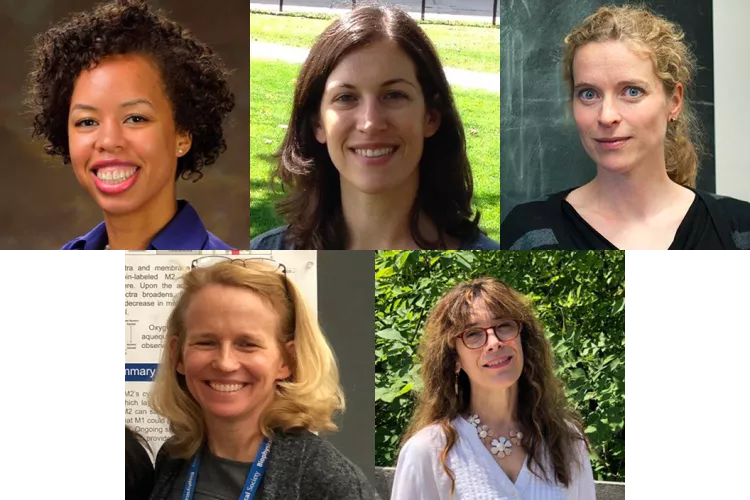Five Women in the Sciences Receive Major Federal Grants

Clockwise from top left: Assistant Professor of Physics Cacey Bester, Assistant Professor of Biology Dawn Carone, Associate Professor of Biology Eva-Maria Collins, Walter Kemp Professor in the Natural Sciences and Professor of Physics Amy Graves, and Professor of Chemistry Kathleen Howard.
Five female faculty members in the sciences recently received major federal grants, highlighting the ingenuity and passion for learning that courses through the College.
Among them are Cacey Bester, assistant professor of physics, and Amy Graves, Walter Kemp Professor in the Natural Sciences and professor of physics — the newest and longest-serving members of the department, respectively. They will support the efforts of Bucknell University physicists Brian Utter and Katharina Vollmayr-Lee on a three-year, $600,000 grant from the National Science Foundation to study properties of granular materials.
The project, detailed last week in The Swarthmorean, aligns Bester’s experimentalist approach with Graves’s computer simulations. Their Research in Undergraduate Institutions award will fund student collaboration on the project, as well as equipment, travel to meetings, and more.
Three faculty members earned grants from the National Institutes of Health (NIH) Academic Research Enhancement Awards program: Assistant Professor of Biology Dawn Carone, Associate Professor of Biology Eva-Maria Collins, and Professor of Chemistry Kathleen Howard. Carone and Howard received awards from NIH’s National Institute of General Medical Sciences division, Collins from the National Institute of Environmental Health Sciences.
Carone, a geneticist, will explore the two-year project “Functional Analysis of Locus-Specific Pericentric Satellite Expression.” The goal is to understand the basic structure and function of specific DNA sequences found near chromosomal centromeres. Tandemly repeated DNA sequences reside in these regions of chromosomes and have been historically poorly studied due to difficulties in their genomic assembly. In cancer cells, these repetitive sequences are misregulated such that they become expressed, and Carone aims to understand both their sequence diversity and consequences of their expression. The project will engage and train students in innovative genomics as well as cytological and proteomics techniques, sparking future careers in genomics and biomedical research.
Howard, a physical chemist, will embark on a three-year study: “Characterization of the interaction of M1 and M2: Influenza A proteins critical to viral assembly.” The threat of future influenza pandemics, coupled with growing resistance to current antiviral drugs, makes the development of new influenza drugs a national health care priority. The project includes experiments to provide an atomic-level understanding of how influenza viruses assemble and then bud from infected cells. This structural information could inform efforts to inhibit the replication of viruses, offering a significant potential for a new generation of anti-flu drugs. The award will also allow students to use cutting-edge biophysical techniques, participate in established interdisciplinary collaborations, be co-authors on published work, and be mentored by experts committed to their long-term career development.
Collins, a systems biologist, will pursue a two-year study on the impact of pesticides on developing brains. Specifically, she will study organophosphorus pesticides (OPs), which account for approximately 40% of recently used insecticides in the U.S. While legal OP concentrations are not acutely toxic to humans, studies suggest that chronic prenatal and infant exposures can lead to lifelong neurological damage and behavioral disorders. Collins will execute a comparative screen of OP neurotoxicity using the asexual freshwater planarian Dugesia japonica. The project will also train students in computational image analysis and biostatistics and engage them in hands-on research in modern toxicology.



